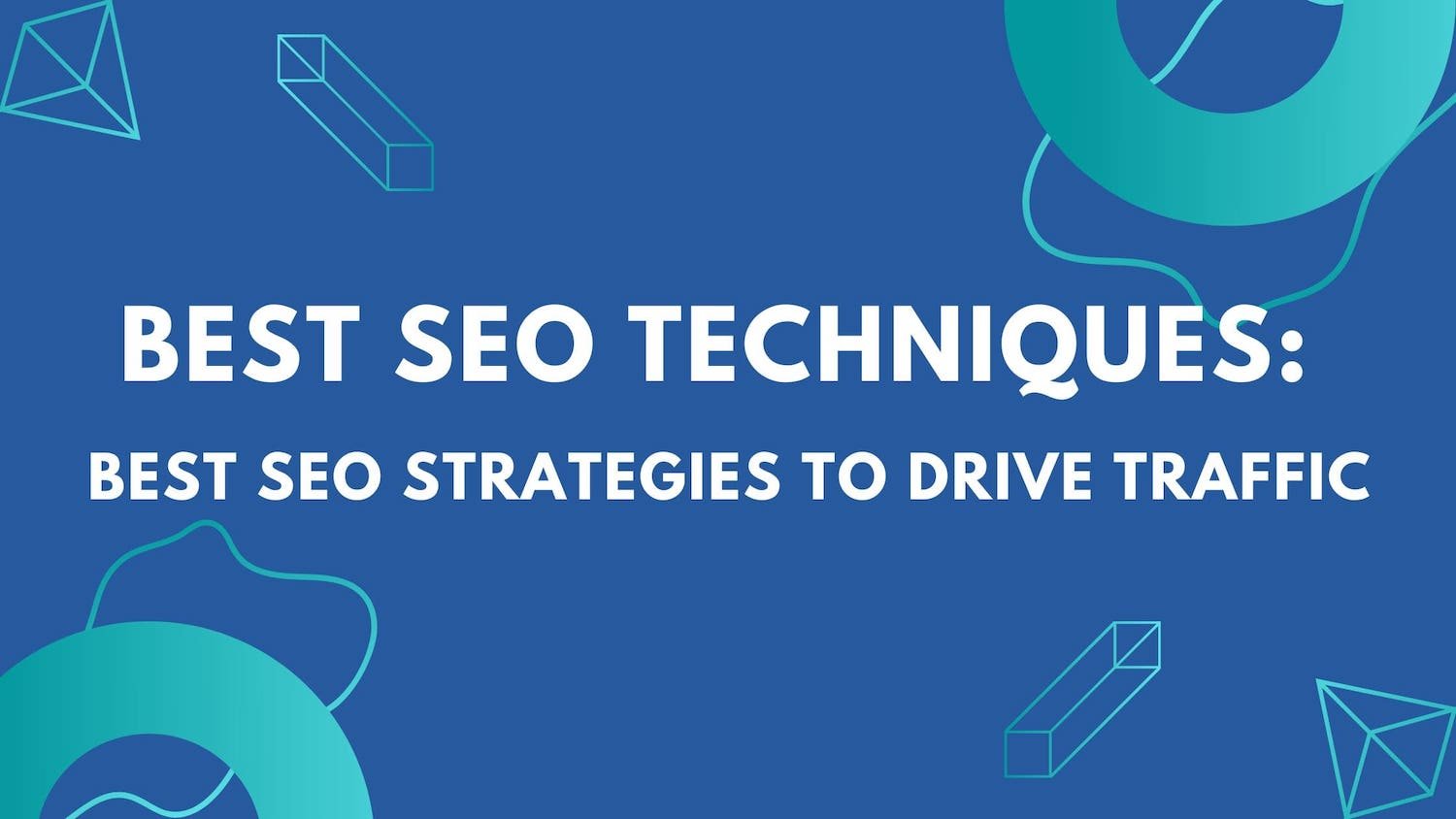You probably understand the various SEO techniques. Where you use White hat search engine optimization (SEO) techniques to increase your website’s organic search traffic and satisfy your digital marketing needs. However, search engine optimization is a complex field that requires in depth knowledge of both the simple techniques as well as the advanced SEO techniques that will ensure that your website succeeds.
However, before you can run, you have to walk. Therefore, it is essential that you understand the basics of SEO first. Basics include understanding SEO tactics like:
Once you have mastered the basic SEO tips, you can move on to more advance SEO strategies and techniques. Therefore, to help you have SEO success in your digital marketing endeavors, we have developed this guide so you can learn more about the 14 best SEO techniques to help you skyrocket your website’s performance and help you step-by-step on how to execute each of these strategies.
Before we move on to the 14 actionable steps to optimize your website, we need to know the different pillars of SEO that can be optimized. The next section discusses on-site off-site and technical SEO.
Table of Contents
Types of search engine optimization:
Before we get into the different SEO techniques, it is important for webmasters to understand the three different elements that make up search engine optimization as a whole. Whereas, on-page, off-page and technical SEO are the three different components of SEO optimization of a website. Moreover, these three components make up three of the 4 pillars of SEO (the fourth is content writing).
Below we give a quick overview of the three search engine optimization types. Make sure to follow the links to dive deeper into each subject.
On-Page SEO:
On-page SEO is the most basic form of search engine optimization and is focused on improving the SEO ranking of your website in search engines by improving the visibility and credibility of your content. This includes things like optimizing your title, description, header, and images for Google, as well as using keyword density and other related keyword research techniques.
Off-page SEO
Off-page SEO refers to all the methods you can use to get your web page ranked higher in search engine results pages (SERPs), including link building, social media promotion, and positive SEO reviews. These components are important aspects of SEO as they help build your domain authority, or online reputation off site.
Technical SEO
Technical SEO focuses on improving the technical aspects of your website so that it looks better when users search for it online. This may include things like fixing broken links, optimizing images for display on mobile devices, and ensuring your site loads quickly.
Before we move onto the actual best SEO techniques, it is important to discuss the two types of techniques that can be used while developing a website. In the next section we discuss white hat and black hat SEO strategies.
Types of SEO techniques: White & black hat
SEO is an umbrella term that covers a range of techniques that are used to improve the visibility and search engine ranking of a website or blog. It includes two main types of SEO, which are white hat and black hat strategies. However, they are not created equal. Let’s examine the difference between the two.
White hat SEO:
These techniques are those that are authorized by search engines, and they involve using well-known, ethical methods to improve a website’s ranking. These methods include things like on-page optimization and off-page optimization that follow Google’s guidelines and are considered ethical methods. White hat SEO methods, are used in longterm SEO strategies that are building websites that are sustainable long-term.
Black hat SEO:
These techniques, on the other hand, involve manipulating search engine rankings in order to get your website or blog more exposure. This can include things like spamming, cloaking (using different keywords in different locations on your site), and using fake reviews. While these tactics may help you get short-term gains, they can ultimately damage your site’s reputation and hurt your chances of future success.
When it comes to deciding which SEO tactics to use, we strongly recommend using white hat SEO methods only. This is because black hat, and even gray hat SEO methods can end up harming your website’s overall performance over the long run. White hat is the safe and sustainable way to build and increase a website’s traffic.
14 Best SEO techniques to drive more traffic
It is essential to not only implement the best SEO techniques but to ensure that they are white hat SEO strategies as we mentioned.
Whether you’re running a blog, an e-commerce website, or a physical store, conducting search engine optimization will help your business get found by search engines and drive new customers to your business.
The best part about this blog post is we are going to give you actionable ideas which will help your digital marketing efforts, without you needing to purchase any SEO services! All of our SEO tips utilize white hat SEO to increase the visibility of your website on search engines.
Listed below are the SEO techniques that you need to focus on in order to increase website traffic and improve visibility on Google Search. So let’s get started with the first SEO technique!
1. Look into competitor’s high performance pages
It’s always a good idea to be aware of your competitors SEO strategy – what they are upto, what are they ranking for and how does their SEO roadmap looks like.
After you figure out what’s working for their websites to rank better in the search engine, you can use your analysis to the next level and understand why a specific approach is working before using this strategy to your own approach.
One of the effective ways to start is looking out for your competitors high performing pages so that it helps you to develop a picture of where and how they are receiving organic traffic from, and what drives that traffic. By conducting an SEO competitor analysis of your competition’s best pages you can identify the gaps and give you directions like:
- Content and keyword gap
- Link gap
- Improve existing content
- Keyword cannibalization
To conduct an SEO audit and check your competitors best pages you can use Ahrefs, Semrush or Ubersuggest SEO tools.
- On the left side of the bar, click on “Site Audit” and enter the URL of your competitor
- This will provide you information on the site’s overall performance.

However, you might want to dive deeper and check which pages or what type of content is receiving organic traffic.
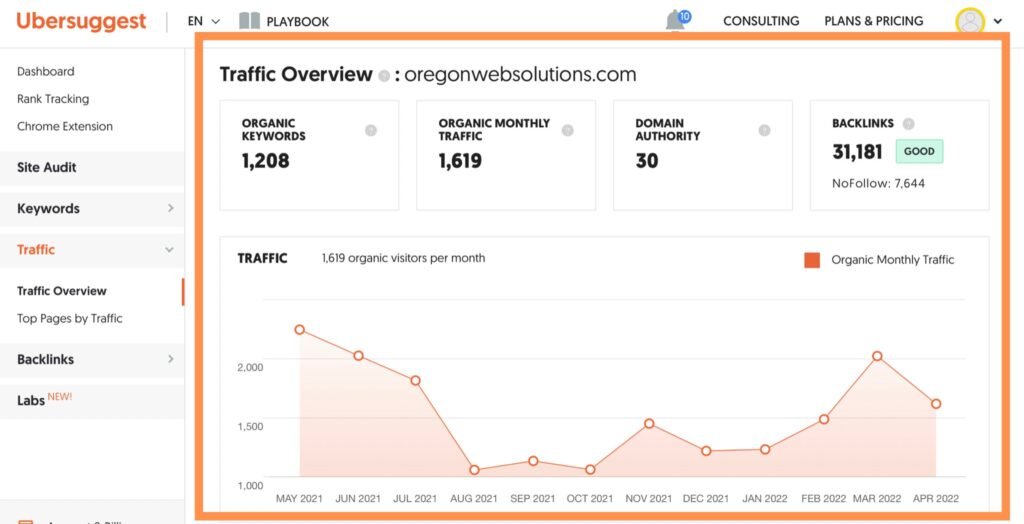
If you click on the “Organic monthly traffic” as you can see on the first page it will give you a traffic overview coming to their site.
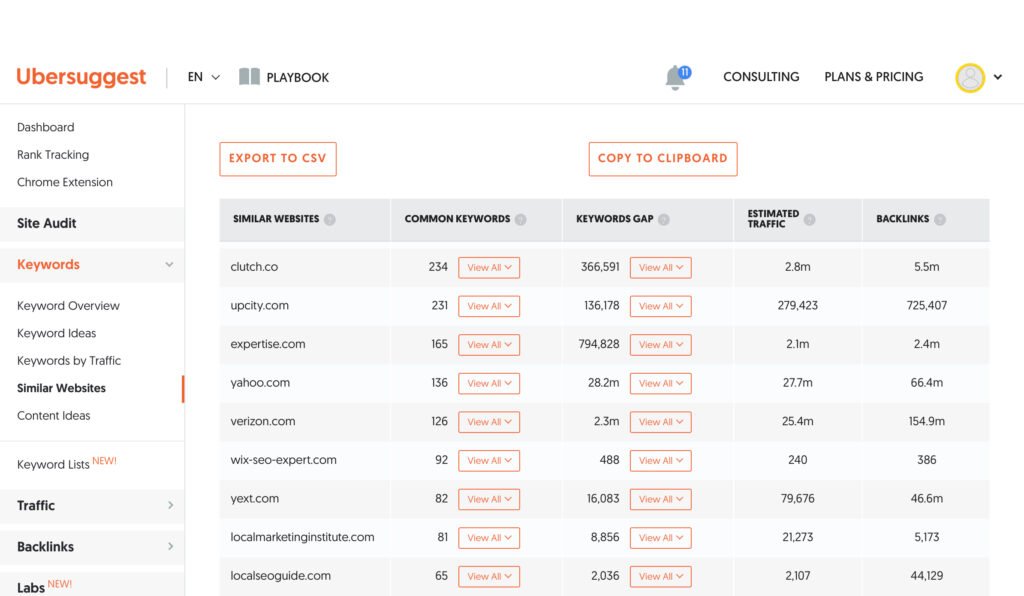
Now, to see which pages are doing better, scroll down and you will see data on “Top SEO Pages”. Click on the button to see a longer list of which pages are doing better compared to your pages. This will show you monthly data on estimated visits, backlinks and no. of shares on different social media platforms.
This is one of the easiest ways to find out what pages are driving higher traffic to competing websites. This insight will help you level up your game and form a strategy to steal some of that traffic.
Look at this as an opportunity to analyze your competition and a quick way to figure out where you can achieve big wins based on competition’s activity, rather than starting with keyword research.
This will help you significantly to determine potential areas to focus your SEO efforts at an on-page level, rather than keyword level. You can also look for other websites that compete against your own that maybe you hadn’t considered to be a competitor.
2. Analyze your content strategy using keyword analysis
Content strategy isn’t an easy task and revolves around two major focus areas:
- Creating new content
- Optimization of old content
Optimizing old content is often the most effective way to start as it’s easier to get new gains from improving content that is already indexed compared to new content. By doing this even most of the websites will get to a point where they have optimized all of their outdated content.
However, your effort should be on creating new unique content. Many SEOs do the mistake of blindly creating any content without giving any thought process to it.
Any new content created needs to have a purpose and needs to justify why all content you’ve created exists. This means crafting and putting effort while creating the content strategy that will bring you results.
One of the fastest ways to steer your content plan is by conducting a keyword gap analysis that will help you analyze keywords your competitors rank for but you don’t. By doing this, it will help you give a direction to create content focusing on those keywords and topics to fill the gap.
Head to any of the tools but for now we will be using Ubersuggest’s Keyword Gap tool.

- Open the site, to your left underneath the Keywords tab, click on Similar Websites
- Then, enter your domain
- The tool will give you a list of similar websites, common keywords, keywords gap, backlinks and monthly traffic
By doing this, it will help you find keyword gaps related to your industry and competitors. For further detailed information, click on the “keyword gap” and see all the keywords that your competitors rank for but that you don’t.
Additionally, while doing the keyword research gap, filter the keywords by volume or keyword difficulty. However, it also depends whether you have sufficient site authority to compete for higher volume search queries. For example, if you’re fairly a new site, you might want to target keywords that have lower difficulty and search terms.
You can utilize keyword gaps to create a content strategy that will help you rank for keywords that your competitors have been ranking for.
Keyword hack – Optimize keywords better:
In addition to Ubersuggest, you can also use Google Search Console (GSC) and your Google Analytics to drill down on where your search traffic is coming from and which keyword phrase you should target for individual website page SEO.
For example, if you use your Google Search Console performance tool, you can look at each page to understand the exact keyword phrase it is being found for. These high impression, and click through keywords, can then be utilize in your blog posts, with a focus on meta descriptions, title tags, and header tags.
As an SEO tool, GSC can be extremely valuable. However, it is important to remember, if you don’t have high quality content, the SEO tool, SEO strategy, and SEO technique will produce zero results for your content marketing efforts. Always, focus on quality content first, otherwise nothing else matters (literally because no one will stay to read your content if they find it!)
3. Earn authoritative backlinks through digital PR
It is known fact that one of the biggest challenges for website owners is how to earn high authority backlinks at a scale.
Building backlinks is considered one of the top ranking factors of Google. Though there are several link building tactics that can help to successfully earn relevant links, the fact remains that many strategies are hard to scale effectively.
Google’s link schemes guidelines also makes recommendations that are pretty straightforward:
The best way to get other sites to create high-quality relevant links to yours is to create unique, relevant content that can naturally gain popularity in the internet community. Creating good content pays off: links are usually editorial votes given by choice, and the more useful content you have, the greater the chances someone else will find that content valuable to their readers and link to it.
This is where digital PR comes in. It will help you earn editorially placed links by creating amazing content.
When creating content, think about the purpose. Your purpose is to build backlinks, which means creating content and promoting content to publishers and journalists that they might want to cover and link for from within their articles. These content can be in the form of:
- Infographics
- Tools
- Expert insights/ opinions
- Research studies
Long story short, think like a PR and execute like an SEO. However, don’t confuse digital PR with a sales pitch. Digital PR is promoting linkable assets with a strong outreach tactic. Your job is to ensure that the right story can deliver a significant amount of editorially earned links from publications.
Some benefits that digital PR gives you rather than links, include:
- Driving referral traffic
- Creating social engagement
- Increasing brand awareness
- Exposure of your brand in front of your customers
- Generating sales
4. PPC tests to improve organic click-through rate (CTR)
Click through rate is a contributing ranking factor and should be optimized for all funnels in your website. But first let’s go through the elements that can potentially impact your site’s click-through rate. They are:
- Title tag
- Meta description
You can have fair amount of control over these elements but how do you know what title tag or meta description will give you the highest CTR?
Answer: you test it.
This could take a while as you’re making changes and measuring the results with also other variables that might come to play. However, if you don’t want to wait for too long for results, you can use PPC to test the title tags and meta descriptions.
While you’re testing these elements, you don’t necessarily need to run a campaign for your business but it’s worth adding a budget and setting up ads for a few pages to test different title tags and meta descriptions. It’s important to note that you’re not going to get “likes” for all the title tags and meta descriptions due to the way ads present headlines and descriptions. However, you will get some powerful data related to key phrases and headings.
Some key points to ensure that you’ve properly set up the test to determine what’s having the most impact on CTR.
- While testing for title tags, test at least three different headlines and keep the descriptions the same for each.
- While testing for meta descriptions, test at least three different descriptions and keep the headline or title the same for each
As long as you receive enough clicks on your ad, you will be able to rewrite your titles and meta descriptions using this data and substantially improve your CTR.
Recommended Reading: How to Use Header Tags – SEO Best Practices
5. Don’t miss out on “People Also Ask”
If you want to start ranking in the first of SERPs, you need to optimize “People Also Ask” section that you see in the search result as shown below:
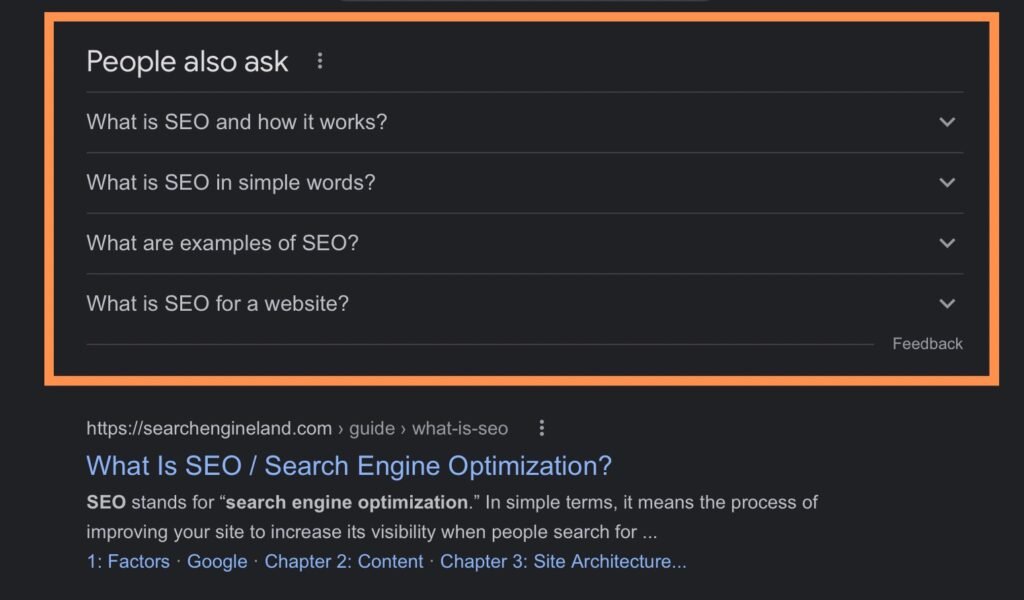
A study conducted by Semrush shows that, the average percentage of SERPs with People Also Ask has grown to about 60- 65% for both desktop and mobile. But besides those data, there are many reasons why you should pay more attention to People Also Ask.
- They help you rank easily on page 1, with the possibility to hold a People Also Ask result and first page ranking, unlike featured snippets.
- They help you stand out at the top of the SERPs as it directly answers what the customer is asking.
- They can be used to refine your query for the kinds of questions that Google might struggle to interpret.
Many marketers don’t pay attention to People Also Ask and this means it’s an opportunity for you to gain a competitive advantage over them.
6. Steal broken backlinks
As we already know how difficult it is to build high quality backlinks, however, there is one strategy that you use is a variant of broken link building.
Thought this strategy is based on finding broken links, creating a content that fits the link, reaching out to try and get it repointed to your content, will help you give a head start.
You can use Ahrefs Free Broken Link Checker tool to check your competitors’ broken pages.

The pages that show a 4XX error are not receiving PageRank through the links that are pointing to them.
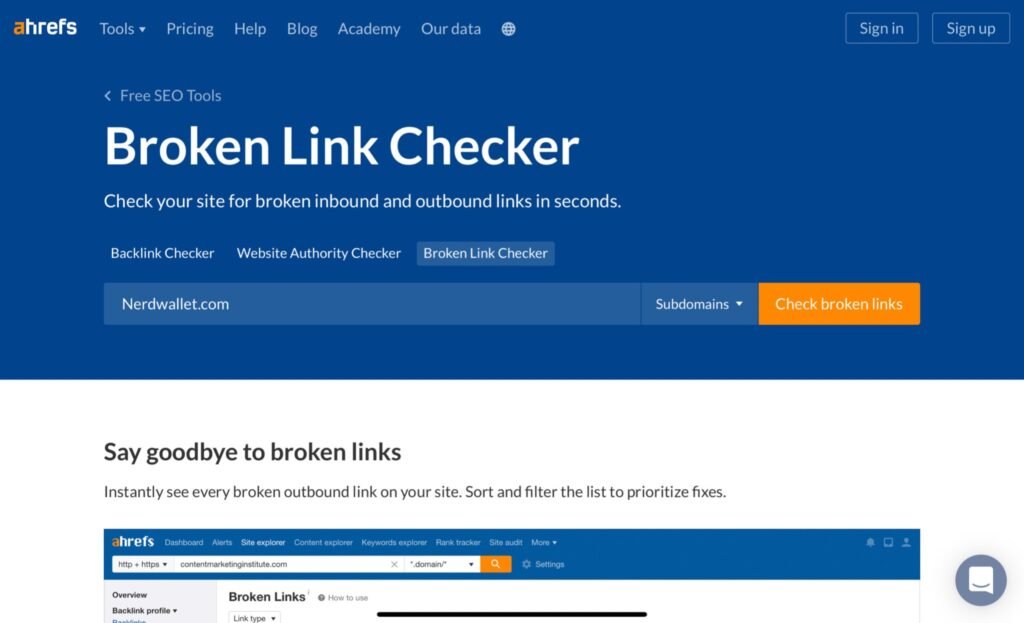
You will see a number of referring domains that are linking to a particular page. It will make sense to start with this metric as unique referring domains are considered one of the better measures building successful links.
It is worth noting that to start reaching out and creating similar content to domains that have “Follow” links. These are the opportunities that could help replace the broken links. This will also help to prevent a bad user experience when a visitor clicks onto a dead link on their site.
7. Show topical expertise by using supportive content
It is obvious that Google wants to rank the best relevant result for any given query and that’s why it’s essential to think about optimizing for topics and not just keywords.
For instance, you need to portray topical authority and expertise to have a chance of ranking at the top of the search results for your “money” keywords. And this means creating topical content that will add value to your money keywords.
This is also one of the ways of creating cluster content that will help to internally link back to a pillar page. These are more comprehensive pages that answer a specific query about your broad topic and link back to the main pillar page. This SEO tactic will allow you to also create content that is optimized for long-tail keywords.
Think supporting content as a piece that will help to add more depth to a topic and shows to Google that you have expertise in a specific topic or your field. However, it’s essential to note that content doesn’t need to be created based on keyword research insights.
Publishing content on trending topics or subtopics is as important as writing opinion articles that gain more traction on social media or other platforms.
Supporting content cannot drive thousands of organic traffic on its own but will contribute in ranking your main pages higher in search results and earn its own organic traffic through other channels, if promoted correctly. Additionally, it will help your SEO blog overall, if you’re internal linking posts to one another.
8. Use internal links
Do you have keywords that rank on page 2 and need boosting onto the first page of search results? Adding internal links that point to these pages could significantly help you achieve higher rankings.
Internal linking is a very underutilized SEO technique and passes both link authority and relevancy signals. To make the most of internal linking, you first need to find opportunities to boost page 2 positions.
To do this you can use Semrush’s Organic Research tool. Enter your domain name and click the “Positions” tab.
Now, you can filter the tab from positions 11-20. It will give you a list of search queries ranking on page 2 that could benefit from an internal linking boost.
9. Optimize for image search
It’s one of the SEO steps that marketers most likely miss out on is optimizing for image search. As much as it is crucial to optimize your website, image optimization is also a contributing factor to your SEO.
If you haven’t done image optimization, chances are that you’ve been missing out on grabbing traffic from a source that your competitors probably aren’t considering. Let’s not forget that visual search is a BIG deal.
Image optimization is more than just tagging images with alt tags. If your images are properly optimized, you actually have a higher chance of ranking prominently on the image search results.
So, where do you start right?
Here are some points that you need to consider while optimizing your images:
- Alt tags
- Proper file names
- Resizing images to the required dimensions
- Reducing file size
- Creating an image sitemap
- Hosting your images on a CDN
It might take a lot of time to go back and optimize all your old images, but it is worth creating a process of adding and uploading images in the future to ensure that all these steps will tick from the start.
10. Optimize for Core Web Vitals
In 2021, Google started to place more emphasis on page and user experience as ranking factors. As a result, the focus shifted towards several on-page UX elements such as:
- Safe browsing
- Mobile-friendliness
- HTTPS
- Intrusive interstitial
However, the biggest change has been the introduction of Core Web Vitals, which became a ranking signal in August 2021.
Core Web Vitals are a collection of metrics around responsiveness, speed and visual stability, defined as:
- Largest Contentful Paint (LCP): The amount of time that take for the main content page to load. The ideal time is 2.5 seconds or faster.
- First Input Delay (FID): The amount of time that takes for a page to become interactive, that being less than 100 milliseconds.
- Cumulative Layout Shift (CLS): The amount of layout shift of the visual content page that is unexpected, with the time ideally being less than 0.1.
As Google says:
Core Web Vitals are the subset of Web Vitals that apply to all web pages, should be measured by all site owners, and will be surfaced across all Google tools. Each of the Core Web Vitals represents a distinct facet of the user experience, is measurable in the field, and reflects the real-world experience of a critical user-centric outcome.
You can easily audit the performance of your core web vitals in Ubersuggest’s site audit and get recommendations on how to improve them.

11. Update outdated content:
One of the best SEO techniques you can use is to update outdated content. This will help you rank higher in search engine results pages (SERPs), as Google is always looking for updated, fresh and relevant information.
By updating your content regularly, you will also make sure that your website remains user-friendly and engaging for visitors. This will keep them coming back, which in turn will help you attract more traffic and boost your rankings even further. You can also use various SEO techniques to help improve your website’s visibility in search engines, such as link building and social sharing.
Updating your website with new content will help to improve your site’s overall quality score and may even result in a sudden increase in traffic. Not only that, but it will also help you to stand out from the competition by providing users with the most up-to-date information available.
12. Focus on local SEO:
If you’re looking to drive more traffic from local search results, then make sure you’re targeting the right keywords and putting in the effort to optimize your website for local search. This includes things like geo-targeting your website within specific geographic regions as specific as possible (for example, Portland, Oregon), ensuring that your site is easy to find and containing relevant information about your business (for example, reviews or ratings).
Local SEO is one of the most important inbound marketing techniques for businesses providing local services and products. So here are a few things that you need to keep in mind when doing local SEO:
- Make sure your website is easy to find and navigate. This includes adding localized keywords and other appropriate tags, as well as making sure your website looks good and functions properly on different devices and browsers
- Create quality content that’s relevant to the local area. This will help you rank higher in search engine results pages (SERPs)
- Sign up for a Google Business Profile (Google My Business)
13. Implement E-A-T best practices
E-A-T is a term used in SEO that means expertise, authority, and trust. E-A-T is a ranking factor developed by Google that aims to reward content creators that are writing about topics that they are experts in. By penalizing content produced by an unreliable expert, it is an additional ranking criterion that aims to reward material created by a knowledgeable specialist.
Writing content that meets the demands of Google’s Quality Evaluator Guidelines, is an important SEO technique to master. Whereas depending on the niche you are trying to rank for, E-A-T may apply differently. For example, it is absolutely necessary for a YMYL (Your Money or Your Life) niche that a content creator uses the E-A-T modality. This is because if someone is looking for advice on YMYL topics like financial and medical, Google does not want to showcase low-quality content that could affect a visitor’s life negatively.
In order to utilize this SEO technique for content writing and to increase website traffic is by creating high-quality, well-written content that is authoritative and trusty. You can do this by using expert sources, including experts in your field, as well as credible sources that have a good reputation.
14. Go after featured snippets
SERPs are dominated by featured snippets these days. Even if you haven’t heard the term before, it’s likely that you’re familiar with them. Snippets are highlighted sections of text, photos, videos, and lists that Google has determined provides the best answer to the particular search query. You’re doing something right if you manage to win a featured snippet.
To increase your chances of landing a featured snippet, there are a few formatting and styling choices you can make: bullet points, numbered lists, infographics, and answering question-based searches directly. Despite the fact that pieces do not always produce immediate clicks, over 19% of SERPs have featured pieces. They’re ideal for establishing your brand name and getting your company noticed. As a result, clicks will continue to be heard.
Going after featured snippets is one of the best SEO tactics a website can employ. Whereas, by winning a snippet, the website’s content is propelled to the coveted ‘Position 0’ spot on search engine results. Ultimately, even if your page cant rank number 1 for a certain search query, by optimizing your content for a snippet, you can still ensure that your page will get plenty of visibility.
Key takeaway: Top SEO tactics
As we’ve always highlighted, SEO is a consistent process and if you want to continue to see your website’s organic traffic grow, you need to go beyond the basics and dive deeper into SEO techniques. By utilizing the basic as well as some of the more advanced SEO tactics we have highlighted in this blog post, you will help take your site and its organic traffic to the next level.
Remember, you don’t need to rush when it comes to optimizing your content with these 14 best SEO techniques. Whereas it is easy to get burnt out, and end up taking shortcuts while optimizing your on-page SEO, off-page SEO, and technical SEO. Which, in the end, will only cost you more time and money.
Take your time while implementing these techniques and ensure that you are consistent with your effort level as well as quality. Take the time to research and look for opportunities that your competition isn’t utilizing or taking advantage of, so you can use them in your successful SEO campaign.
Overall, make a strategy, implement it regularly, and stick to it for the long run. If you do this, we are certain you will improve your website’s SEO performance!
If you’re looking to increase organic traffic or online presence, Clear Door SEO is an SEO agency in Portland Oregon, who provides an array of SEO services to online businesses. You can book a free consultation with us!
